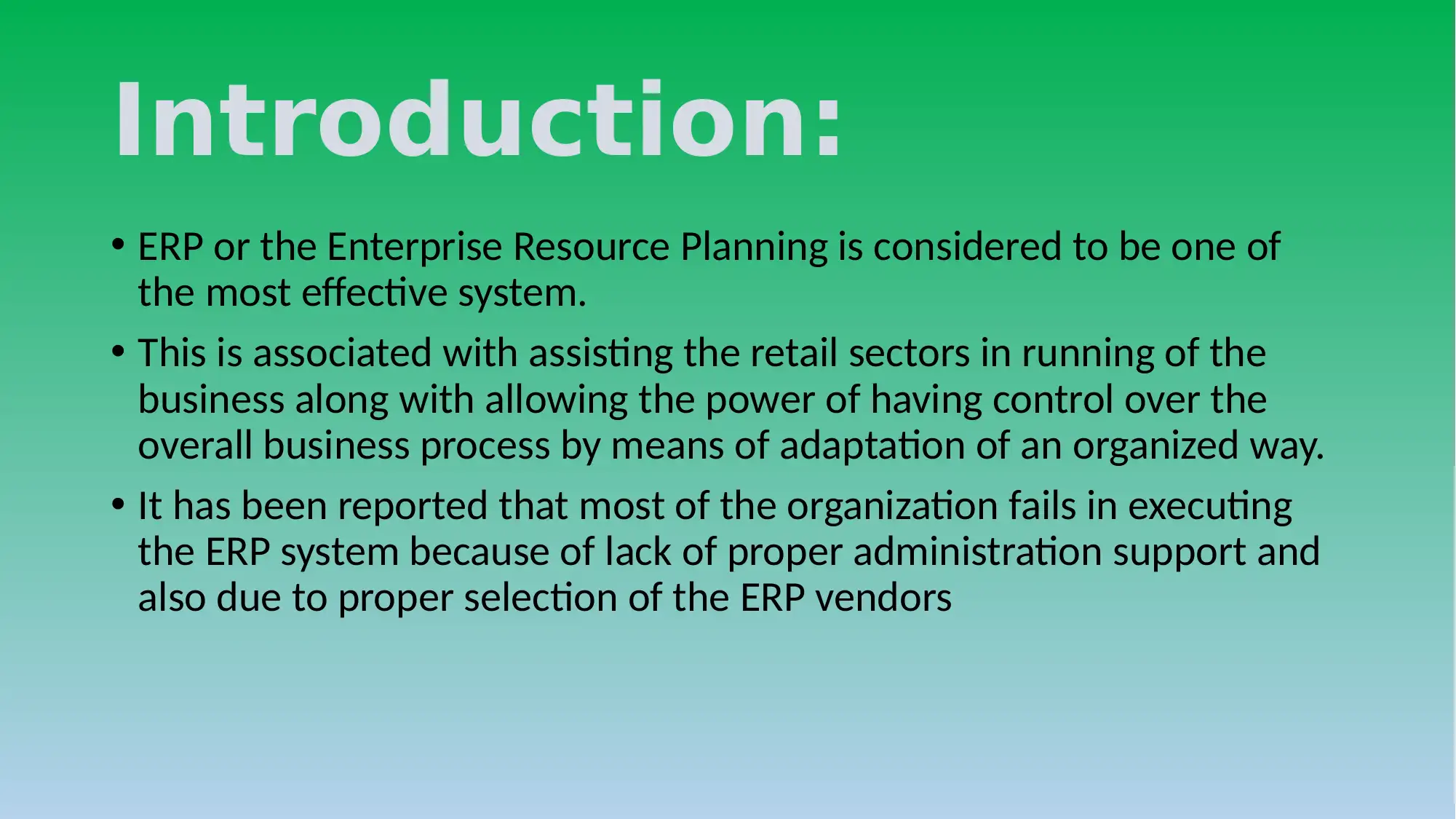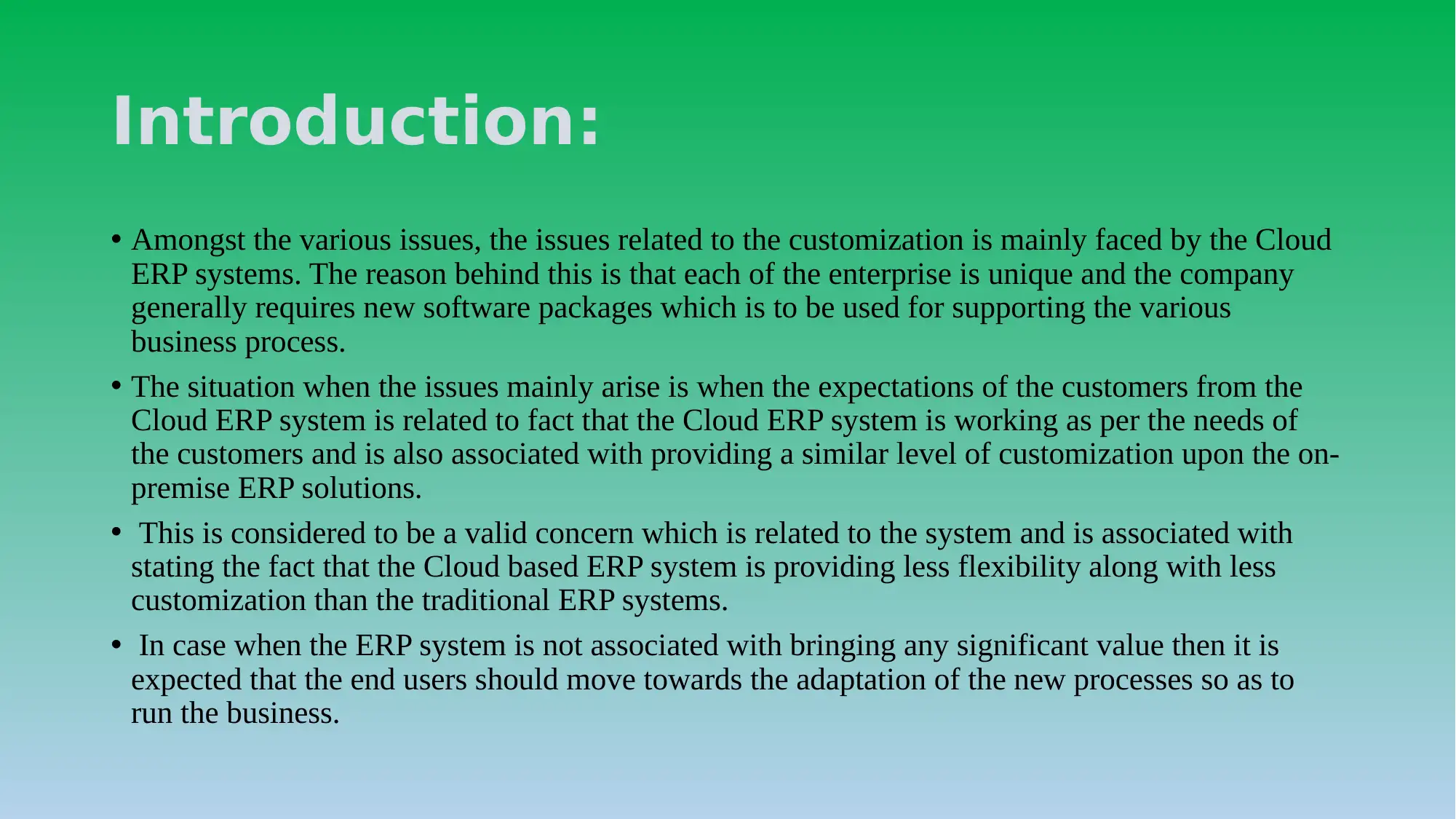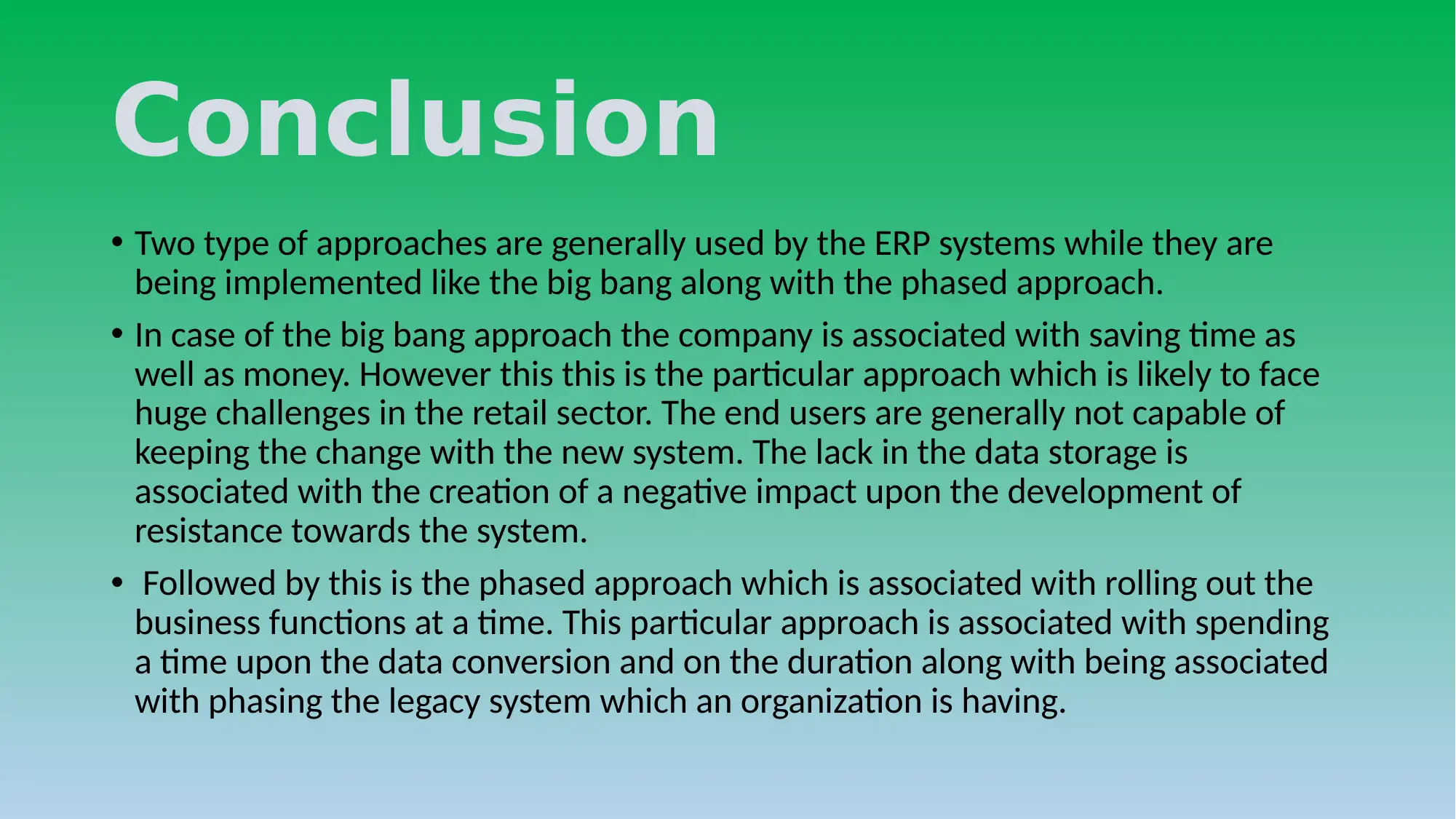RSCP7004: Analyzing Cloud ERP Customization in Saudi Retail Sector
VerifiedAdded on 2023/04/08
|10
|1038
|142
Report
AI Summary
This report analyzes the customization challenges associated with Cloud ERP systems in the Saudi Arabian retail sector. It highlights the importance of ERP systems in retail, the issues faced during implementation, and the reasons for potential failures. The research aims to understand these challenges and the reasons for non-implementation, reviewing existing research on ERP challenges. The methodology employs an explanatory research design to understand the impact of increased knowledge and the nature of the problem. The report concludes by discussing security concerns, customization issues, provider lock-in, flexibility, and data ownership as key challenges, and examines the big bang and phased approaches to ERP implementation, noting the potential difficulties of the big bang approach in the retail sector due to end-user adaptation and data storage limitations. It also addresses the inflexibility of legacy systems and their impact on integrating with current market products. Desklib provides access to this and other solved assignments to aid student learning.

RESEARCH SKILLS AND
CONSULTANCY
PLANNING
Analysis on the customization challenges associated with Cloud ERP
System in Retail Sector at Saudi Arabia
CONSULTANCY
PLANNING
Analysis on the customization challenges associated with Cloud ERP
System in Retail Sector at Saudi Arabia
Paraphrase This Document
Need a fresh take? Get an instant paraphrase of this document with our AI Paraphraser

Introduction:
• ERP or the Enterprise Resource Planning is considered to be one of
the most effective system.
• This is associated with assisting the retail sectors in running of the
business along with allowing the power of having control over the
overall business process by means of adaptation of an organized way.
• It has been reported that most of the organization fails in executing
the ERP system because of lack of proper administration support and
also due to proper selection of the ERP vendors
• ERP or the Enterprise Resource Planning is considered to be one of
the most effective system.
• This is associated with assisting the retail sectors in running of the
business along with allowing the power of having control over the
overall business process by means of adaptation of an organized way.
• It has been reported that most of the organization fails in executing
the ERP system because of lack of proper administration support and
also due to proper selection of the ERP vendors

Introduction:
• Amongst the various issues, the issues related to the customization is mainly faced by the Cloud
ERP systems. The reason behind this is that each of the enterprise is unique and the company
generally requires new software packages which is to be used for supporting the various
business process.
• The situation when the issues mainly arise is when the expectations of the customers from the
Cloud ERP system is related to fact that the Cloud ERP system is working as per the needs of
the customers and is also associated with providing a similar level of customization upon the on-
premise ERP solutions.
• This is considered to be a valid concern which is related to the system and is associated with
stating the fact that the Cloud based ERP system is providing less flexibility along with less
customization than the traditional ERP systems.
• In case when the ERP system is not associated with bringing any significant value then it is
expected that the end users should move towards the adaptation of the new processes so as to
run the business.
• Amongst the various issues, the issues related to the customization is mainly faced by the Cloud
ERP systems. The reason behind this is that each of the enterprise is unique and the company
generally requires new software packages which is to be used for supporting the various
business process.
• The situation when the issues mainly arise is when the expectations of the customers from the
Cloud ERP system is related to fact that the Cloud ERP system is working as per the needs of
the customers and is also associated with providing a similar level of customization upon the on-
premise ERP solutions.
• This is considered to be a valid concern which is related to the system and is associated with
stating the fact that the Cloud based ERP system is providing less flexibility along with less
customization than the traditional ERP systems.
• In case when the ERP system is not associated with bringing any significant value then it is
expected that the end users should move towards the adaptation of the new processes so as to
run the business.
⊘ This is a preview!⊘
Do you want full access?
Subscribe today to unlock all pages.

Trusted by 1+ million students worldwide

Introduction:
The main aim of this research study includes the
following:
• Providing of a brief understanding of the
challenges related to customization which are
generally faced by the retail sector because of
the Cloud ERP system implementation.
• Besides this the study is also aimed at
analyzing the key reasons for not
implementing the ERP system. This study is
going to assist the researchers in having a
better understanding of the various situations
related to the usage of the cloud based ERP
within the retail business sector.
• One of the major aim also includes meeting
the objectives of the research study along
with briefly reviewing the research conducted
upon the challenges faced by the ERP.
Major Components of Retail ERP System
The main aim of this research study includes the
following:
• Providing of a brief understanding of the
challenges related to customization which are
generally faced by the retail sector because of
the Cloud ERP system implementation.
• Besides this the study is also aimed at
analyzing the key reasons for not
implementing the ERP system. This study is
going to assist the researchers in having a
better understanding of the various situations
related to the usage of the cloud based ERP
within the retail business sector.
• One of the major aim also includes meeting
the objectives of the research study along
with briefly reviewing the research conducted
upon the challenges faced by the ERP.
Major Components of Retail ERP System
Paraphrase This Document
Need a fresh take? Get an instant paraphrase of this document with our AI Paraphraser

Research Design
• One of the most significant factor of the research methodology includes a well structures sequential approach for
helping eth researchers in conducting the entire research successfully.
• The research design is basically considered to be blueprint of the entire research work which is associated with
discussing the entire research plan in detail by means of analyzing the entire data. There exists three type of research
design and it is associated with including the descriptive research design, explanatory research design and the
exploratory research design.
• This particular research study would be associated with choosing the explanatory design for the purpose of assisting
and understanding the impact of the increased knowledge amongst the individuals.
• One of the most significant factor of the research methodology includes a well structures sequential approach for
helping eth researchers in conducting the entire research successfully.
• The research design is basically considered to be blueprint of the entire research work which is associated with
discussing the entire research plan in detail by means of analyzing the entire data. There exists three type of research
design and it is associated with including the descriptive research design, explanatory research design and the
exploratory research design.
• This particular research study would be associated with choosing the explanatory design for the purpose of assisting
and understanding the impact of the increased knowledge amongst the individuals.

Research Design
•Besides this the researcher would also become capable of understanding the nature of the problem faced by the
research along with the purpose by usage of the experience and the knowledge of the researchers.
•The usage of this particular research design would be helping the researchers in the identification of the research
gaps along with the limitations which are caused due to particular resources.
•Once the research limitations are identified successfully the researcher would become capable of taking certain
possible steps for the purpose of improving the research method so as to complete the entire project by meeting the
mentioned research objectives.
•Besides this the researcher would also become capable of understanding the nature of the problem faced by the
research along with the purpose by usage of the experience and the knowledge of the researchers.
•The usage of this particular research design would be helping the researchers in the identification of the research
gaps along with the limitations which are caused due to particular resources.
•Once the research limitations are identified successfully the researcher would become capable of taking certain
possible steps for the purpose of improving the research method so as to complete the entire project by meeting the
mentioned research objectives.
⊘ This is a preview!⊘
Do you want full access?
Subscribe today to unlock all pages.

Trusted by 1+ million students worldwide

Conclusion:
• The research is mainly associated with discussing about the challenges that are
faced by the cloud based ERP systems that are being used in the retail sector.
• However it is observed that the aspects of each retail sector is different from the
other and for this reason the challenges are also seen to be varying in accordance
to the retail sector.
• Some of the challenges mainly includes the security related issues, issues related
to customization, lock-in of the providers, flexibility, and data ownership.
• This issues are in turn associated with having a huge impact upon the selection of
the appropriate type of cloud ERP system which are required by the various retail
enterprises. Because of the impact upon the business there also exists a huge
impact upon the businesses which are conducted by means of the ERP system.
• The research is mainly associated with discussing about the challenges that are
faced by the cloud based ERP systems that are being used in the retail sector.
• However it is observed that the aspects of each retail sector is different from the
other and for this reason the challenges are also seen to be varying in accordance
to the retail sector.
• Some of the challenges mainly includes the security related issues, issues related
to customization, lock-in of the providers, flexibility, and data ownership.
• This issues are in turn associated with having a huge impact upon the selection of
the appropriate type of cloud ERP system which are required by the various retail
enterprises. Because of the impact upon the business there also exists a huge
impact upon the businesses which are conducted by means of the ERP system.
Paraphrase This Document
Need a fresh take? Get an instant paraphrase of this document with our AI Paraphraser

Conclusion
• Two type of approaches are generally used by the ERP systems while they are
being implemented like the big bang along with the phased approach.
• In case of the big bang approach the company is associated with saving time as
well as money. However this this is the particular approach which is likely to face
huge challenges in the retail sector. The end users are generally not capable of
keeping the change with the new system. The lack in the data storage is
associated with the creation of a negative impact upon the development of
resistance towards the system.
• Followed by this is the phased approach which is associated with rolling out the
business functions at a time. This particular approach is associated with spending
a time upon the data conversion and on the duration along with being associated
with phasing the legacy system which an organization is having.
• Two type of approaches are generally used by the ERP systems while they are
being implemented like the big bang along with the phased approach.
• In case of the big bang approach the company is associated with saving time as
well as money. However this this is the particular approach which is likely to face
huge challenges in the retail sector. The end users are generally not capable of
keeping the change with the new system. The lack in the data storage is
associated with the creation of a negative impact upon the development of
resistance towards the system.
• Followed by this is the phased approach which is associated with rolling out the
business functions at a time. This particular approach is associated with spending
a time upon the data conversion and on the duration along with being associated
with phasing the legacy system which an organization is having.

Conclusion
Due to the outdated architecture of
legacy of most of the enterprises it is
associated with providing a structure to
the retail sectors which along with
being inflexible is also rigid. Besides this
the lack of flexibility is also associated
with preventing the usage of the legacy
software with the current products
which are obtainable from the market
and this in turn would be associated
with adding of value to the retailing
business operations.
Analysis of the
current
situation
System
Delivery
Improvement
Process
Application Training
system
organizing
Incorporation
of Information
System
Detection of
problems and
Business
Process
New Process
Development
Implementation process of Cloud Based ERP system
Due to the outdated architecture of
legacy of most of the enterprises it is
associated with providing a structure to
the retail sectors which along with
being inflexible is also rigid. Besides this
the lack of flexibility is also associated
with preventing the usage of the legacy
software with the current products
which are obtainable from the market
and this in turn would be associated
with adding of value to the retailing
business operations.
Analysis of the
current
situation
System
Delivery
Improvement
Process
Application Training
system
organizing
Incorporation
of Information
System
Detection of
problems and
Business
Process
New Process
Development
Implementation process of Cloud Based ERP system
⊘ This is a preview!⊘
Do you want full access?
Subscribe today to unlock all pages.

Trusted by 1+ million students worldwide

1 out of 10
Related Documents
Your All-in-One AI-Powered Toolkit for Academic Success.
+13062052269
info@desklib.com
Available 24*7 on WhatsApp / Email
![[object Object]](/_next/static/media/star-bottom.7253800d.svg)
Unlock your academic potential
Copyright © 2020–2025 A2Z Services. All Rights Reserved. Developed and managed by ZUCOL.



![Enterprise Systems ePortfolio Assessment Report - [University Name]](/_next/image/?url=https%3A%2F%2Fdesklib.com%2Fmedia%2Fimages%2Fmc%2F7ee5e66af19f4214a437b2ca633d86d8.jpg&w=256&q=75)

